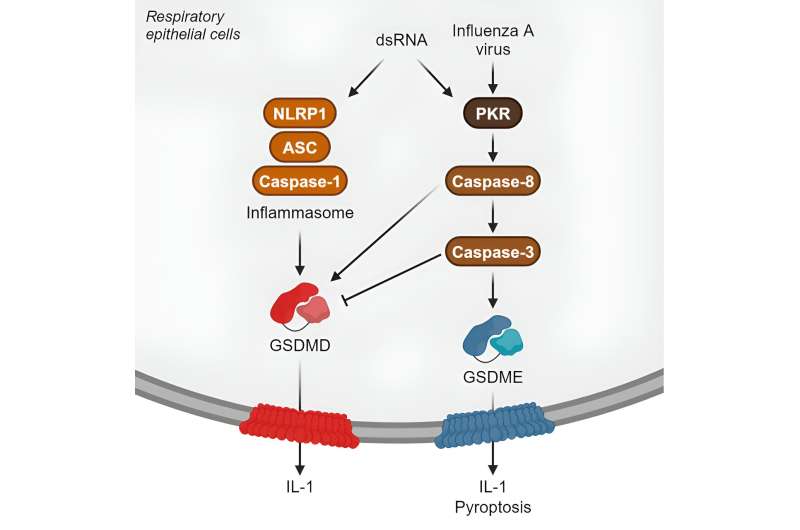This article has been reviewed according to Science X's editorial process and policies. Editors have highlighted the following attributes while ensuring the content's credibility:
fact-checked
peer-reviewed publication
trusted source
proofread
Scientists discover how lung cells induce immune response to influenza

Researchers from Trinity have discovered some new and surprising ways that viral RNA and influenza virus are detected by human lung cells, which has potential implications for treating people affected by such viruses.
Influenza viruses remain a major threat to human health and can cause severe symptoms in young, elderly, and immuno-compromised populations, leading to annual epidemics which endanger between 3 and 5 million people of severe illness and cause 290,000 to 650,000 deaths worldwide.
These viruses primarily target respiratory epithelial cells to replicate, where they cause cell damage and death. Scientists have become aware that these epithelial cells are not mere passive barriers, helpless to attack, but instead are vital in driving the antiviral immune response.
However, until now, our understanding of the mechanism underpinning that response has been very limited. Now, thanks to work performed by Ph.D. student Coralie Guy, in the research team of Andrew Bowie, Professor of Innate Immunology in Trinity's School of Biochemistry and Immunology, some answers have arisen.
The team discovered that viral RNA and influenza viruses stimulate two different molecular pathways in which specific proteins set off chain reactions that result in two proteins called "gasdermin D" and "gasdermin E" being processed in such a way that they form membrane pores in the epithelial cells.
These pores allow the release of special agent "cytokines" charged with sparking the immune system into life, and also cause death of the cells which prevents the virus spreading.
To assess the importance of this finding, the team suppressed the formation of the gasdermin pores to see what would happen, and this resulted in increased replication of influenza viruses, underlining how important these gasdermins are in the antiviral response.
The research has just been published in the journal iScience. Speaking about the research and its implications, Professor Bowie, who is based in Trinity's Biomedical Sciences Institute, said, "By forming an EU-wide network of scientists with different expertise in immunology and virology, we were able to ask some fundamental questions about how our bodies respond to RNA viruses such as influenza and SARS-CoV-2.
"We realized that very little was known about the initial response to viruses in those early moments when our lungs first encounter a virus. Through Coralie's work we were able to make some important discoveries that highlight previously unknown aspects of the immune response to influenza, which we will now build on to examine how relevant they are to other viral infections of the lung, such as SARS-CoV-2 and RSV."
More information: Coralie Guy et al, Viral sensing by epithelial cells involves PKR- and caspase-3-dependent generation of gasdermin E pores, iScience (2023). DOI: 10.1016/j.isci.2023.107698


















